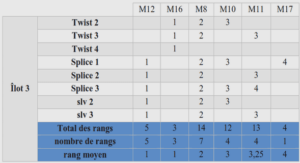A characterization of NST models and their associated polynomials
Dans ce chapitre, on a proposé une caractérisation par fonction variance des modèles NST multivariés sur Rk décrits par Boubacar Maïnassara & Kokonendji (2014). Ces modèles sont composés d’une variable stable-Tweedie positive fixée et des variables gaussiennes indépendantes conditionnées par la première, de mêmes paramètres de dispersion égale à la variable fixée. Étant donné un vecteur aléatoire (X1; : : : ; Xk)> 2 Rk, les modèles NST multivariés sont générés par la mesures -finies p;t on Rk (avec p 1 et t > 0) données par : (m), et arriver à caractériser analytiquement les NST par leurs fonctions variances en distinguant les cas limites p = 1 et p = 2. Les lois NST étant indéfiniment divisible pour p 1, la nature des polynômes associés à ces modèles a été décrite à l’aide des propriétés de la quasi orthogonalité, des systèmes de Lévy-Sheer et des relations de récurrences correspondantes. An important problem in statistical analysis is how to choose an adequate family of distributions or statistical model to describe the study. For this purpose, the characterization theorems can be useful because, under general reasonable suppositions related to the nature of the experiment, they allow us to reduce the possible set of distributions that can be used. One of these reasonable assumptions is that the normal stable Tweedie (NST) models (Bou- bacar Maïnassara & Kokonendji, 2014) present particular forms of variance functions based on the first component of mean vector and a probability mea- sure which is not easy to handle. So, a characterization by variance functions or by associated polynomials is required for the analysis related to this mo- del. Recall that variance function plays a significant role in the classification of natural exponential families (NEF). Thus, the NEFs can be characterizedby variance functions obtained by successive dierentiations of the Laplace transform of a positive measure. Also, the variance functions are convenient to identify a family that is, for example, a Laplace transform to identify a probability distribution.
Polynomials associated with NST models
Throughout this section, the NST laws are associated to the Lévy processes (Xt)t>0 because each distribution p;t defined in (3.2) is infinitely divisible for given p 1 ; see, e.g., Sato (1999). As NEF (from t) we associate to NST models (from p;t) the polynomials in (2.1) denoted here by PA;n;p;t for a given power variance parameter p 1. As for p 2 [1; 1) n f2; 3; : : :g the characterizations by modifications of ortho- gonality property are not available. In particular, the normal Poisson polyno- mials with p = 1 need more investigations. Beside this, the Poisson-Gaussian polynomials are orthogonals (see Pommeret, 1996) because they are in the simple quadratic families of Casalis (1996). See Nisa et al. (2015) and Koko- nendji & Nisa (2016) for short discussion and dierences between normal Poisson and Poisson-Gaussian families. We mainly show that, given the variance function (3.7) with fixed p 1 then, up to anity, the corresponding cumulant function is that introduced in (2.3) with t = 1. For problems of existence, we first proving the limits cases (p = 1; p = 2) then the cas p 2 (1; 2) [ (2; 1). From (2.51) and since m1 > 0 and mj 2 R for all p 2 (1; 2) [ (2; 1), one has : (1 a1) < 0 which can be extended to 0 when p > 2 (see also (2.54) below) and (j aj) 2 R for j 2 f2; : : : ; kg. Hence, up to anity (see Proposition 1.4.1) the set introduced for (2.17) is similar to the one of (3.4).



